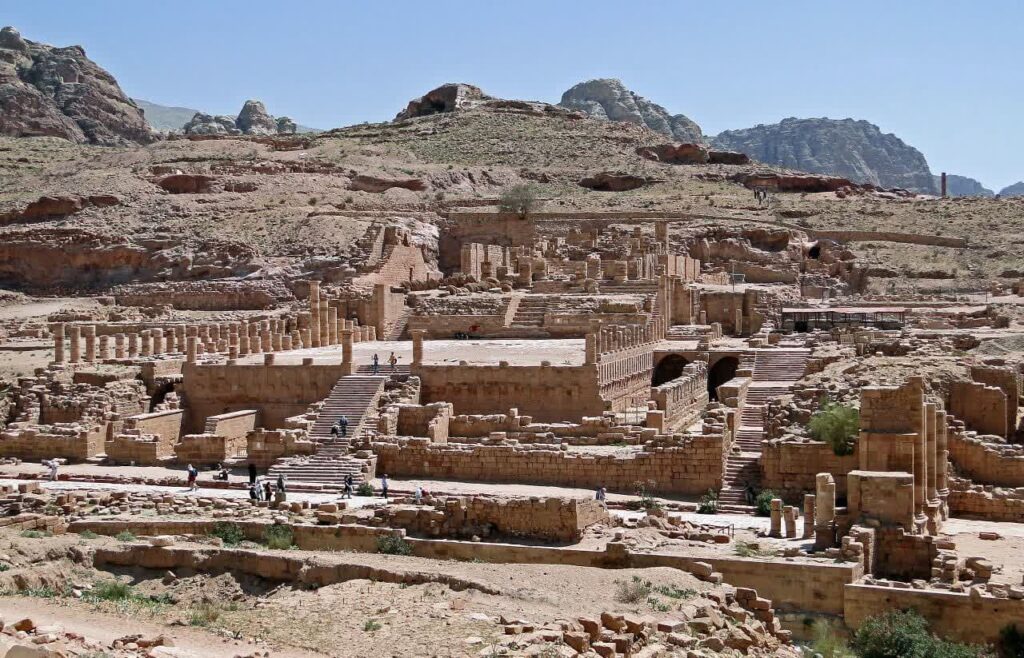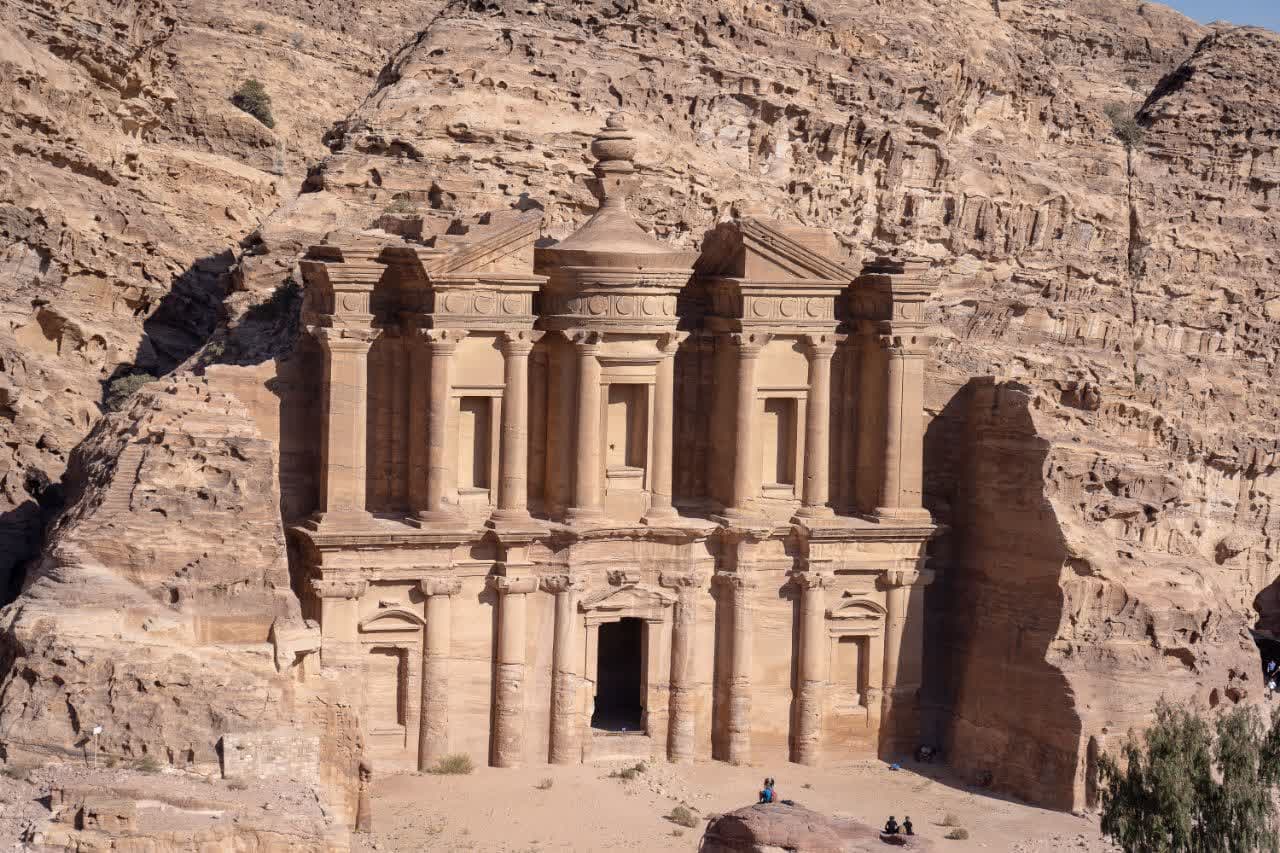Nestled amidst the rugged landscapes of Jordan lies Petra, an ancient stone city steeped in history and mystery. From its enigmatic rock-cut architecture to its role as a vital hub of trade and culture, Petra’s evolution unfolds a tale of civilization, ingenuity, and resilience.
Table of Contents
Ancient Origins of Petra
Petra traces its origins back to the Nabateans, an ancient Arab civilization that thrived in the region around 400 BCE. Positioned at the crossroads of major trade routes, Petra flourished as a vital center of commerce, linking the Arabian Peninsula, Egypt, and the Mediterranean world. Its strategic location enabled the Nabateans to amass wealth and power, evident in the grandeur of Petra’s architectural marvels.
Architectural Marvels of Petra
The crown jewel of Petra is undoubtedly the Treasury (Al-Khazneh), an imposing temple carved into the rose-red cliffs. This iconic structure, adorned with intricate carvings and elaborate facades, serves as a testament to the Nabateans’ mastery of rock-cut architecture. Beyond the Treasury lie a plethora of palaces, temples, and tombs, each bearing witness to Petra’s rich cultural heritage and artistic prowess.
Cultural Significance of Petra
Petra not only served as a thriving center of trade but also as a melting pot of cultures, religions, and ideas. The Nabateans, with their cosmopolitan outlook, embraced influences from the surrounding regions, resulting in a unique blend of architectural styles, religious beliefs, and societal norms. The city’s rock-cut tombs, adorned with intricate carvings and inscriptions, offer glimpses into Nabatean religious practices and funerary rituals.
Religious Influence
In ancient Petra, religion played a central role in shaping daily life and societal dynamics. The Nabateans, who inhabited Petra, practiced a polytheistic religion characterized by the worship of a pantheon of deities associated with natural phenomena, fertility, and protection. Temples and shrines dedicated to these gods and goddesses dotted the landscape, serving as focal points for religious rituals, ceremonies, and offerings. Among the most prominent deities venerated in Petra were Dushara, the principal god associated with fertility and prosperity, and Al-Uzza, the goddess of protection and war.
The archaeological remains of Petra provide valuable insights into the religious beliefs and practices of its inhabitants. The city boasts numerous religious structures, including temples, altars, and sacrificial sites, which offer clues about the Nabateans’ spiritual worldview and rituals. The Temple of Dushara, located near the center of Petra, stands as a testament to the importance of the god Dushara in Nabatean religious life. Carved reliefs, inscriptions, and artifacts discovered within the temple complex shed light on the rituals performed to honor Dushara and seek his favor for abundant harvests, fertility, and protection from harm.
The religious landscape of Petra also reflected the cultural diversity and influences of neighboring civilizations. As a vital hub of trade and commerce, Petra welcomed merchants, travelers, and pilgrims from across the ancient Near East, facilitating the exchange of ideas, beliefs, and religious practices. Influences from Hellenistic, Roman, and indigenous Arabian traditions can be discerned in Petra’s religious architecture, iconography, and inscriptions, underscoring the city’s role as a vibrant crossroads of cultures and faiths in antiquity.
Modern Exploration and Preservation Efforts
In the modern era, Petra’s allure has captivated explorers, archaeologists, and tourists alike. European adventurers in the 19th century rediscovered the ancient city, sparking renewed interest in its exploration and preservation. Today, Petra stands as a UNESCO World Heritage Site, a testament to humanity’s commitment to safeguarding our shared cultural heritage for future generations.

Visitor Experience at Petra
For modern-day visitors, Petra offers a journey back in time, a chance to walk in the footsteps of ancient traders and pilgrims. The Siq, a narrow canyon flanked by towering cliffs, serves as the gateway to Petra, setting the stage for a dramatic entrance. As visitors emerge from the Siq, they are greeted by the awe-inspiring sight of the Treasury, its rose-red facade bathed in the golden hues of the desert sun. Exploring Petra’s winding streets, hidden tombs, and ancient monuments, visitors are transported to a bygone era of splendor and grandeur.
The Controversy
The controversy surrounding the identification of Mecca as Petra stems from historical and archaeological debates that challenge traditional narratives of Islamic history. Some scholars and researchers propose that the original holy city of Islam was not Mecca in present-day Saudi Arabia but rather Petra, located in modern-day Jordan. This theory is based on interpretations of ancient texts, archaeological findings, and geographical evidence.
Proponents of the Petra hypothesis argue that several discrepancies exist between the descriptions of Mecca in early Islamic sources and the physical characteristics of the city. They point to the absence of archaeological evidence supporting Mecca’s status as a major trading hub during the time of the Prophet Muhammad, as well as the lack of mention of Mecca in non-Islamic texts from the same period. Additionally, some researchers suggest that certain geographical features mentioned in Islamic texts align more closely with the landscape around Petra than with Mecca.
However, the Petra hypothesis remains highly controversial and is not widely accepted within the academic and Islamic scholarly communities. Critics argue that the theory relies heavily on speculative interpretations and overlooks substantial historical and textual evidence supporting Mecca’s traditional status as the birthplace of Islam. They emphasize the significance of Mecca in Islamic tradition, citing the city’s central role in religious pilgrimage, the presence of ancient landmarks such as the Kaaba, and the continuity of Mecca’s religious significance throughout Islamic history.
Ultimately, the controversy surrounding Mecca as Petra reflects larger debates within Islamic studies and historical research about the interpretation of ancient texts, the reliability of archaeological evidence, and the construction of historical narratives. While proponents of the Petra hypothesis continue to investigate and promote their theories, the majority of scholars and Muslims maintain Mecca’s traditional status as the holiest city in Islam.
Conclusion
Petra’s legacy endures as a testament to the ingenuity, creativity, and resilience of the human spirit. From its humble beginnings as a trading outpost to its zenith as a cosmopolitan metropolis, Petra continues to inspire wonder and fascination, inviting visitors to unravel its mysteries and marvel at its beauty. As we explore Petra’s ancient streets and towering monuments, we are reminded of the enduring power of culture, history, and heritage to connect us across time and space.

